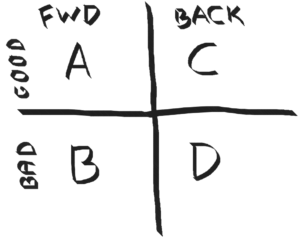“…in this world nothing can be said to be certain, except death and taxes.”
– Benjamin Franklin, 1789
We can add a third item to Franklin’s famous dictum: discomfort.
There is no enduring escape from pain and discomfort for as long as we are alive.
Accepting this, it matters how you approach activities that cause you discomfort.
LEANING FORWARD OR LEANING BACK
“You know the antidote to exhaustion is not necessarily rest ….
The antidote to exhaustion is wholeheartedness.”
– Brother David Steindl-Rast
There are two fundamental attitudes towards activity: leaning forward and leaning back.
Do you remember the first time you rode a giant rollercoaster?
I was 8 years old and barely passed the hight requirement.
As we went uphill for a minute that seemed like ten, I remember wanting to avoid the fall.
The moment the coach seemed to pause, right before leaping into a semi vertical dive, I was completely leaning back: fear, aversion, not wanting to be there.
Contrast this experience with similar rides once I started leaning forward. The rollercoaster of emotions turned into a discomfort I actually wanted to experience: thrill, challenge, being one with the ride. Eventually you even raise your hands in the air, welcoming the rush of emotions.
CONTEXT MATTERS
When should you lean forward or back?
It’s all about the context, some examples can help to illustrate:
A) Leaning forward towards discomfort in a good way
It is a skier leaning forward to gain speed and control.
It is facing the white paper and drawing the first line.
Searching for cover when a rain strom breaks out.
It is typing the next word in this phrase.
B) Leaning forward in a bad way
Taking a shower and speeding up to save 30 seconds.
Asking too many questions, not giving someone the space to be.
Using every idle moment of wait to check your phone.
C) Leaning back away from discomfort in a good way
The same skier in (A) resting in a chair with a warm drink after going downhill.
Going for a walk with the only purpose of getting fresh air.
Turning off your phone to be fully present with family.
D) Leaning back away from discomfort in a bad way
It is not wanting to be were you are and hoping for change instead of acting.
It is waiting for the meeting to finish instead of engaging your mind – in it or something else.
It is tip-toing around the elephant in the room during a difficult conversation.
If you ever feel a subtle sense of unease, chances are you are in the wrong quadrant.
Identify which context applies, adjust your intention forward or backward, and become one with the situation.
BATCHING LEANING FORWARD…
Just as batched production in a bakery shop leads to less wasted effort and more cakes, you can batch your struggle to experience less unnecessary pain and get more results.
For example, next week I will face the following unpleasant activities:
- Work -> admin tasks before the holiday
- Body -> exercise
- Relationships -> difficult conversations
- Mind -> studying japanese
I circle each activity in one clean block of time, usually half an hour to half a day.
When I enter these activities I know they will not be pleasant, but they are much easier to endure by having accepted in advance: “Now is the time to face this discomfort.”
And I will do a better job too.
…AND CYCLING LEANING BACK
Leaning forward into discomfort is only sustainable if my subsconscious can trust that I will be leaning back after the batch is done. Maybe 5 minutes, maybe 5 hours, but there will be a sacred period of leaning back. With that trust, it can accept the immediate challenge and fully engage.
Historically, society tends to function around such cycles of time: the afternoon nap, the weekend, the holiday. Addictive information technology is threatening our ability to switch off, and it becomes our responsiblity to protect our leaning back time of rest.
- Day -> mid morning break, lunch break, afternoon break, evening & night rest
- Week -> weekends
- Year -> holidays (holy-days)
- Multiyear -> seasons such as schooling, early career working, parenting etc.
YOU CANNOT ESCAPE CHAOS
No matter how much you try to organize discomfort, it will show up uninvited.
But 95% of the time you can schedule the big hairy discomforts, drawing a line on the sand.
Eventually, you may find yourself even looking forward to some of the rollercoasters.

Reply